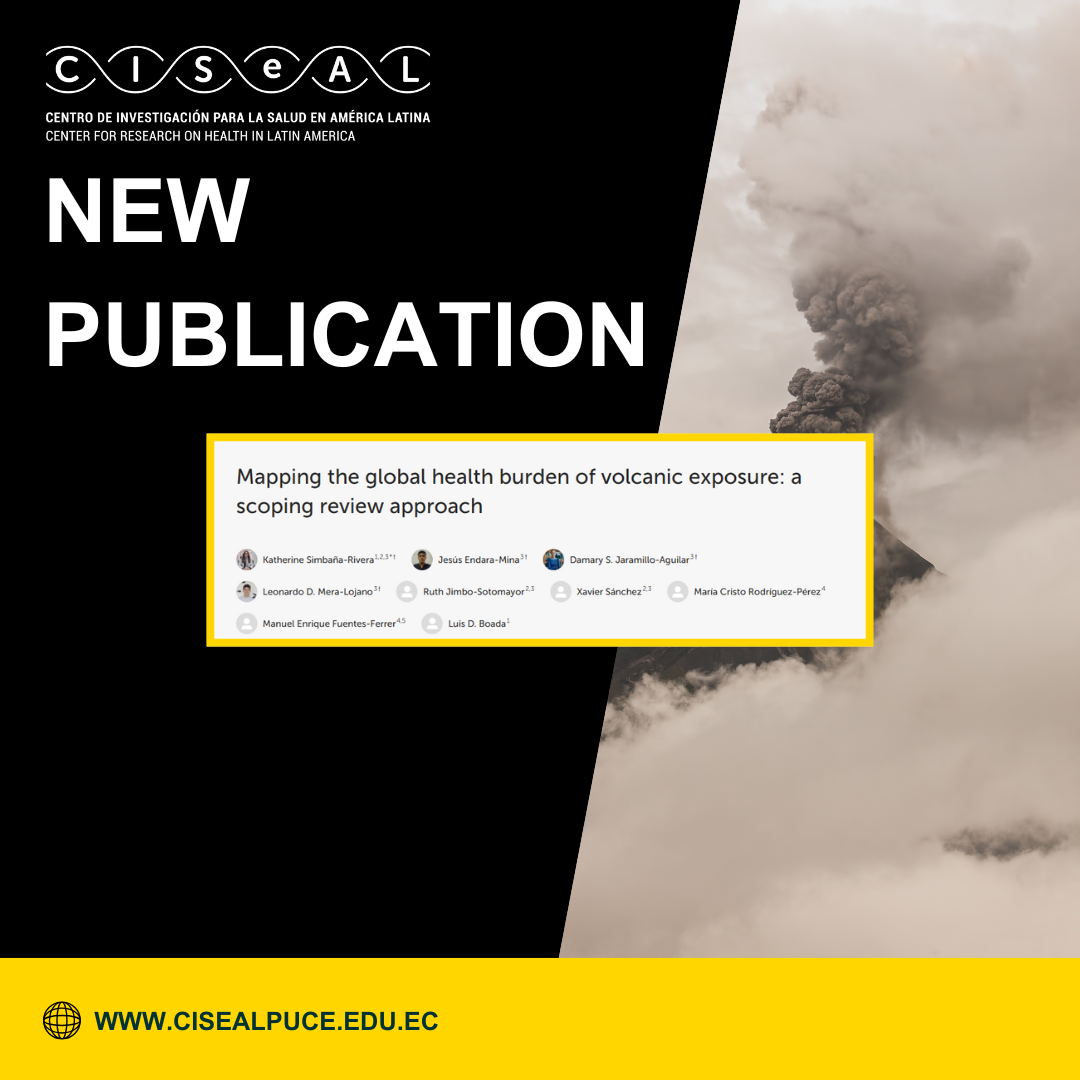 The study conducted by Dr. Katherine Simbaña, Dr. Xavier Sánchez, and Dr. Ruth Jimbo Sotomayor, professors at the School of Medicine of PUCE and researchers at CISeAL, together with other experts, provides a global overview of the health effects of exposure to volcanic activity through a scoping review approach. The research is framed within a context where there are approximately 1,500 potentially active volcanoes worldwide, more than 550 of which have erupted in the past century, with a marked concentration in the Pacific Ring of Fire that runs through densely populated areas of Asia and the Americas. Volcanoes such as Fuego in Guatemala, Popocatépetl in Mexico, Tungurahua in Ecuador, and Merapi in Indonesia have produced highly explosive eruptions with major social and health consequences. The so-called “volcanic products,” which include ash, gases, pyroclastic flows, lava, and chronic emissions of pollutants such as carbon dioxide or radon, have differentiated health impacts depending on their physical and chemical properties, as well as on the duration and magnitude of exposure. In addition, external factors such as climate change, which intensifies secondary phenomena such as lahars or ash resuspension, and social determinants such as poverty, unplanned urbanization, and limited land-use planning significantly increase the vulnerability of populations living in high-risk areas.
The study conducted by Dr. Katherine Simbaña, Dr. Xavier Sánchez, and Dr. Ruth Jimbo Sotomayor, professors at the School of Medicine of PUCE and researchers at CISeAL, together with other experts, provides a global overview of the health effects of exposure to volcanic activity through a scoping review approach. The research is framed within a context where there are approximately 1,500 potentially active volcanoes worldwide, more than 550 of which have erupted in the past century, with a marked concentration in the Pacific Ring of Fire that runs through densely populated areas of Asia and the Americas. Volcanoes such as Fuego in Guatemala, Popocatépetl in Mexico, Tungurahua in Ecuador, and Merapi in Indonesia have produced highly explosive eruptions with major social and health consequences. The so-called “volcanic products,” which include ash, gases, pyroclastic flows, lava, and chronic emissions of pollutants such as carbon dioxide or radon, have differentiated health impacts depending on their physical and chemical properties, as well as on the duration and magnitude of exposure. In addition, external factors such as climate change, which intensifies secondary phenomena such as lahars or ash resuspension, and social determinants such as poverty, unplanned urbanization, and limited land-use planning significantly increase the vulnerability of populations living in high-risk areas.
The study, conducted using the scoping review methodology and following international guidelines such as PRISMA-ScR, included 83 articles after a rigorous selection process that began with 2,077 records identified in databases such as PubMed, Scopus, and Web of Science. The countries with the largest number of publications were the United States, Japan, and Iceland, and among the most studied volcanoes are Mount St. Helens, Kīlauea, Eyjafjallajökull, and Miyakejima. Most of the analyzed studies focused on adult populations, while research on children was less frequent. The most studied pollutants were toxic gases and volcanic ash, both responsible for a wide range of health effects.
The results show that respiratory diseases are the most documented, with more than half of the studies identifying conditions such as asthma, respiratory distress, chronic bronchitis, or chronic obstructive pulmonary disease. These are followed by mental health disorders, including stress, anxiety, depression, and post-traumatic stress reported in communities exposed before, during, and after eruptions. In third place are ocular manifestations such as tearing, burning, blurred vision, or conjunctivitis, while dermatological effects (ulcers, burns, and irritations) and cardiovascular effects (hypertension, acute myocardial infarctions, and other ischemic diseases) were less frequently reported. In total, 90 clinical manifestations related to volcanic exposure were identified, reflecting the multisystemic nature of its health impacts.
The review underscores the importance of integrating clinical, epidemiological, and environmental perspectives in the study of volcanic risks and highlights that, despite advances achieved by international networks such as the International Volcanic Health Hazard Network, information gaps and a lack of comprehensive studies still persist, preventing a more complete understanding of the long-term effects across different population groups. Finally, the researchers emphasize the need to strengthen public health policies, land-use planning, community preparedness, and mitigation strategies in order to reduce the vulnerability of millions of people living near active or potentially active volcanoes around the world.
Did you know that volcanoes not only transform landscapes but also leave a profound mark on the health of the communities exposed to their activity? We invite you to learn more about this topic in the full article available at: https://www.frontiersin.org/journals/public-health/articles/10.3389/fpubh.2025.1658384/full



